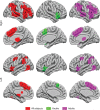Meta-analytic evidence for a joint neural mechanism underlying response inhibition and state anger
- PMID: 32314475
- PMCID: PMC7336147
- DOI: 10.1002/hbm.25004
Meta-analytic evidence for a joint neural mechanism underlying response inhibition and state anger
Abstract
Although anger may weaken response inhibition (RI) by allowing outbursts to bypass deliberate processing, it is equally likely that RI deficits precipitate a state of anger (SA). In adolescents, for instance, anger occurs more frequently and often leads to escalating aggressive behaviors. Even though RI is considered a key component in explaining individual differences in SA expression, the neural overlap between SA and RI remains elusive. Here, we aimed to meta-analytically revisit and update the neural correlates of motor RI, to determine a consistent neural architecture of SA, and to identify their joint neural network. Considering that inhibitory abilities follow a protracted maturation until early adulthood, we additionally computed RI meta-analyses in youths and adults. Using activation likelihood estimation, we calculated twelve meta-analyses across 157 RI and 39 SA experiments on healthy individuals. Consistent with previous findings, RI was associated with a broad frontoparietal network including the anterior insula/inferior frontal gyrus (aI/IFG), premotor and midcingulate cortices, extending into right temporoparietal areas. Youths showed convergent activity in right midcingulate and medial prefrontal areas, left aI/IFG, and the temporal poles. SA, on the other hand, reliably recruited the right aI/IFG and anterior cingulate cortex. Conjunction analyses between RI and SA yielded a single convergence cluster in the right aI/IFG. While frontoparietal networks and bilateral aI are ubiquitously recruited during RI, the right aI/IFG cluster likely represents a node in a dynamically-adjusting monitoring network that integrates salient information thereby facilitating the execution of goal-directed behaviors under highly unpredictable scenarios.
Keywords: activation likelihood meta-analysis; anterior insula, inferior frontal gyrus; frontoparietal; monitoring network; response inhibition; state anger; temporoparietal.
© 2020 The Authors. Human Brain Mapping published by Wiley Periodicals, Inc.
Conflict of interest statement
The authors declare no conflict of interest.
Figures



References
Publication types
MeSH terms
LinkOut - more resources
Full Text Sources

